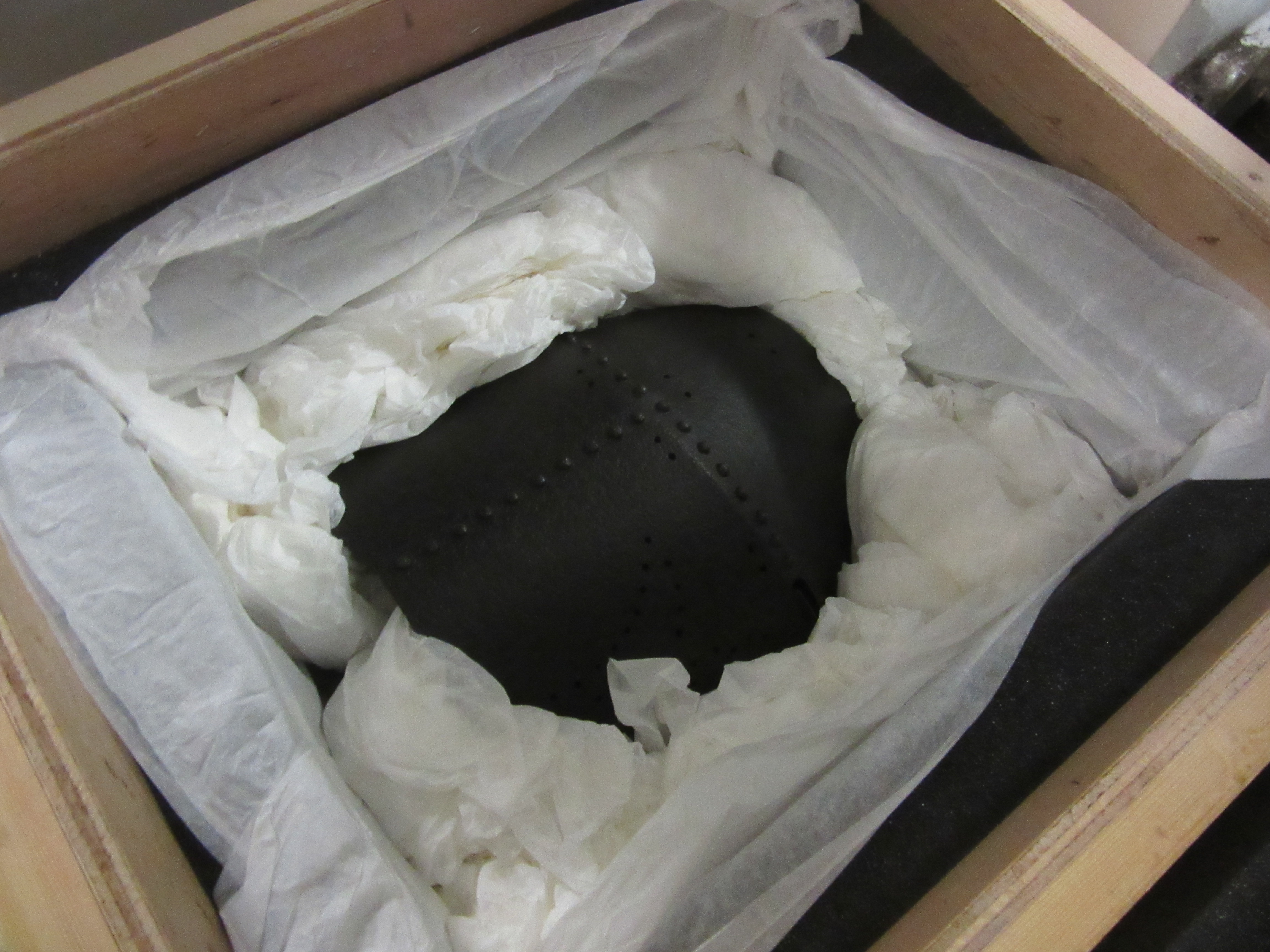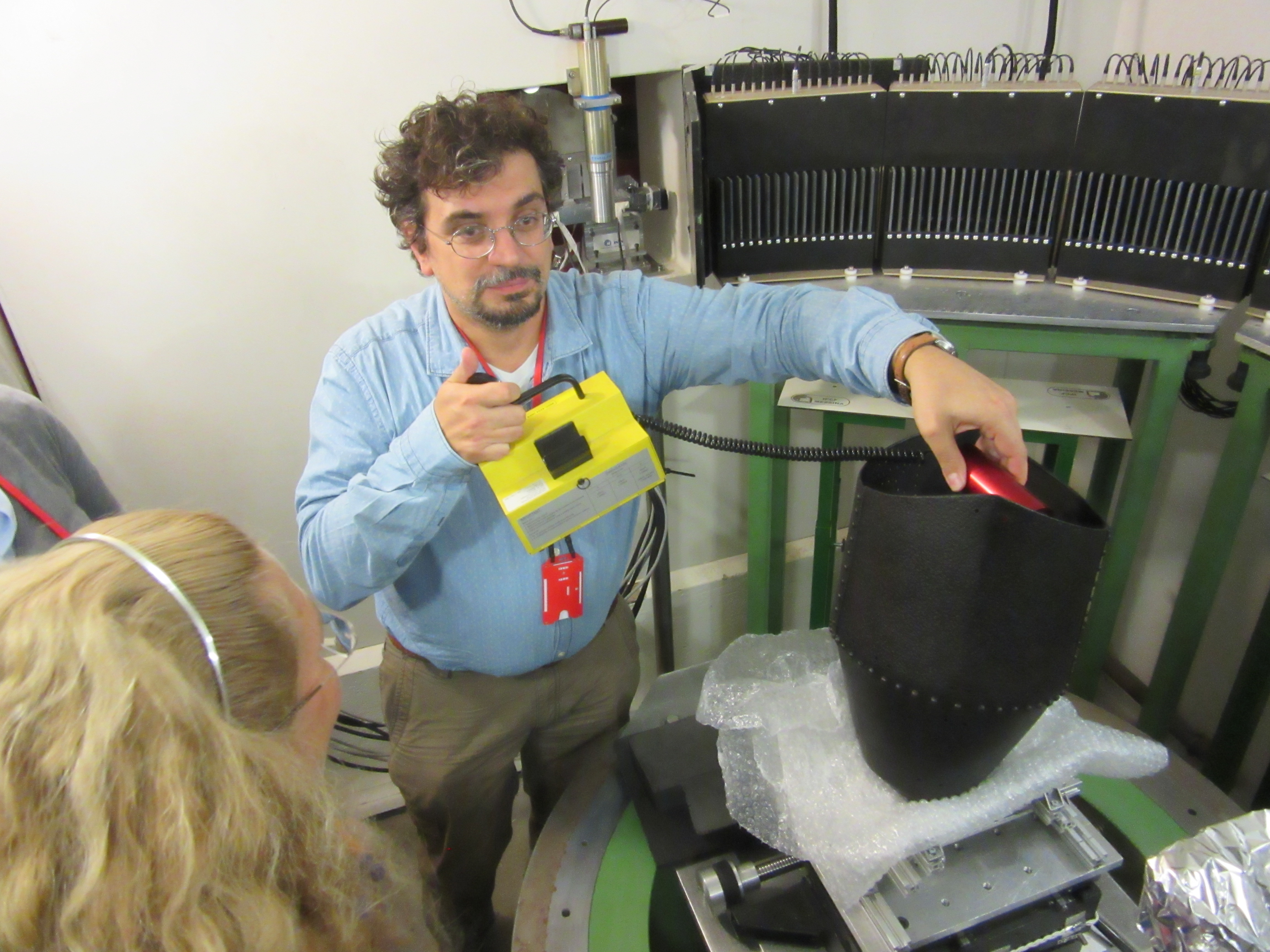The star of the show – the 14th century helm of the Black Prince – went on to become the feature of the BBC current affairs programme 'Inside Out' which aired on TV on Monday 26th February 2018.
Every morning at the ISIS Neutron and Muon Source there is a bright sense of excitement for the day ahead and the possibilities it brings with it. As the sunlight shines through the wide windows of TS1, users finish their night shifts in the experimental halls and head home for some well-deserved rest. Only a few hours later and the hall is back to life with fresh samples, scientists and ideas.
On Tuesday 26th September, this usual sense of anticipation was heightened by a new arrival. There was something else on its way from Canterbury Cathedral; something more goosebump-inducing than the wind of a fresh autumnal morning and it was sealed within a large, airtight wooden crate. Inside the container was the helmet of the Black Prince of England, the 14th century prince who never made it to be king but whose military legacy still echoes through the history books.
| A teaser clip from Inside Out, which aired on BBC 1 at 7.30pm on the 26th of February, video credit: BBC South East twitter. |
|
The team came to ISIS with the intention of using neutron techniques to pinpoint the origin of six Medieval European helmets, whose maker's marks had not stood the test of time. If science could prove that these late 15th century artefacts contain tempered martensite, then that would be very strong evidence that the helmets were made in the Imperial workshop at Innsbruck.
To analyze an artefact, you need to get as deep to the specimen as possible without causing any damage, otherwise you wouldn't have very much left to work with. A conservator's handbook would probably suggest an invasive process such as metallography would be the best choice for studying plate armour. Metallography is the study of the microstructure of metals and metal alloys. It is essentially a fancy term to describe the study of the physical structure and composition of metal compounds. The only problem with metallography is that it requires sampling and/or surface polishing and etching. Additionally, sampling or surface preparation, whilst acceptable in some cases, are not necessarily representative of the object as a whole because only very small areas can be analysed. As this outcome is less than ideal, attention must be focused elsewhere on alternative techniques. Thankfully, this is where neutrons come in.
A neutron is a special kind of particle, which – unlike electrons and protons – has no charge, hence the name 'neutron'. Neutrons are found within atoms which is why they are called subatomic particles and when they impinge onto a sample, they can act like little detectives, penetrating deep into materials without causing them any harm. This means that scientists can learn a lot about the composition and structure at microscopic scale of a historical object whilst maintaining its integrity – a bit like investigating a crime scene with gloves on so as to leave no fingerprints to that tamper with the evidence.

|
The helm arriving at ISIS Neutron and Muon Source.
|
At STFC's ISIS Neutron and Muon Source in Oxfordshire, we have over 30 different Neutron and Muon instruments. These machines give scientists from all over the world the opportunity to complete cutting-edge research in anything from fundamental physics to life and earth sciences. Of these many products of innovative science and engineering, there is one instrument that is often used for cultural heritage studies and its name is INES.
INES is a general-purpose diffractometer which was built in 2005 by the Italian National Research Council (CNR), who currently manage it with the cooperation of STFC. Scientists use diffractometers like INES to measure the atomic and/or magnetic structure of a material. In general terms, diffraction is the process by which a wave (light or particle) bends as it passes around an aperture or the edge of an object. Most diffractometers, however, measure the diffraction of X-rays and in most cases this allows us to paint a picture of the structure of a material. Neutron diffraction is similar to X-ray diffraction but the different type of radiation gives us complementary information. With a neutron beam as powerful as that generated at ISIS, you can get a really good idea about the composition and microstructure of a sample.
“INES offers very good spatial resolution especially in backscattering, enough space to accommodate large objects, alignment facilities like lasers and a neutron camera and x-y table to scan through the samples," explains instrument scientist Dr Antonella Scherillo.
This information was exactly what the team from the Wallace Collection and Canterbury Cathedral wanted to find out when they brought six Medieval European helmets to ISIS back in September. If INES could prove that the helmets were created in Innsbruck, then that would have significant implications from both a scientific and conservation point of view. Were these incredible pieces of medieval metallurgy hand-crafted to be worn in battle or were they simply destined to be ostentatious ornaments, symbolizing both power and status? What about the helmet of the Black Prince? Did that have the same fate as the other helmets?

|
Antonella Scherillo (ISIS, UK) and Francesco Grazzi (CNR, Italy) with the helm on the INES beamline.
|
Under the supervision of Antonella and fellow STFC and CNR scientists, the team- led by Dr Alan Williams from the Wallace Collection, examined each of the six helmets in turn, first measuring them at the top, then the frontal plate, the side and finally the back. The sight was absolutely extraordinary – witnessing 14th century specimens being analysed using a 21st century piece of kit was not your average Tuesday morning at the office, especially when one of those helmets belonged to a prince of England.
After carefully positioning each of the helmets on the INES sample stage, the neutron beam was switched on, a red light appeared and live data began to appear on INES computer screen. The group could then use the collated evidence to determine the quality and kind of steel used in the production of the helmets and the different mechanical and thermal processes that had been used in their manufacture, as well as other components, such as slag. The slag content can then be used to identify bloomery steels – that is – those produced from a bloomery furnace used to smelt iron from its oxides, without melting the iron.
%202.jpg) |
David Edge from the Wallace Collection holding the helm.
|
The results were fascinating. One of the helmets under investigation was examined in 7 places, revealing that heat treatment had been applied to increase its hardness, presumably for battle. The low carbon content of the helmet meant that martensite had not formed but a microstructure of bainite guaranteed a higher hardness than standard steel, with the same composition. Therefore, despite its extraordinary shape, an effort was made to harden it, suggesting its origin as Innsbruck.
But what did neutrons reveal about the Helm of the Black Prince in particular?
“Along with a selection of helmets belonging to the Wallace collection, we had the unique opportunity to examine the helmet of Prince Edward, the Black Prince, which hangs over his tomb in Canterbury Cathedral," explains the team.
“The helmet was measured in three points, and the results showed that it was manufactured using a good quality bloom, therefore it was a helm for the battlefield. Not only that but neutron diffraction revealed that the stress distribution was higher in the front plate, meaning that it has been hardened by cold working or it had been struck in battle."
The story of the analysis of the helm of the Black Prince at ISIS is a classic case of old meeting new, demonstrating that scientific and technological advances can not only reveal new ideas but also unravel old secrets. The outcomes of the study will be of vital importance in future decision making regarding the ethical conservation and restoration of the Arms & Armour collection at the Wallace Collection in London. Furthermore, the team hope that their results, through dissemination via standard academic routes, will influence future decisions about other historical collections in the UK and beyond.
The legacy of the Black Prince is living on.
Further information
Missed BBC South East Inside Out last night? The analysis of the Medieval Helm of the Black Prince featured on the show is available to
catch up on iPlayer for a limited amount of time.
To find out more about the cutting-edge science taking place at ISIS, please follow this
link.
